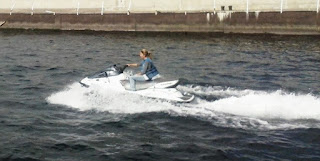http://boatnutmagazine.com/
PWC Stats in Canada, will the numbers of injuries be reflected by the number of PWC's in the market? There are now an estimated 60,000 PWC in Ontario alone and these numbers are growing every month. Is it time to consider something other than a boaters card, I am not a fan of over regulation however these machines are faster and more dangerous than ever.
Figures from RED CROSS
There were 68 fatalities involving personal watercraft (PWC) during 1991-2008, including
33 immersions and 35 trauma deaths (Tables 3a). Traumatic incidents frequently resulted
in head injury, which contributed to at least 32% of PWC trauma deaths. Other injuries
included spinal injury in 18%, fractures in 12%, and major lacerations in 26%. Victims often
sustained multiple injuries
Overall, 19% (13/68) had head injuries, 10% (7/68) spinal injuries, and 16% (11/68)
major lacerations. This compares with 4% (67/1,788) head injuries for other powerboats
and 2% (17/979) for unpowered boats; 1% (11/1,788) spinal injuries for other
powerboats and 0% for unpowered boats; and 2% (28/1,788) major lacerations for
other powerboats and 1% (5/979) for unpowered boats.
PURPOSE
96% of PWC victims died during recreational activities, 1% during occupational
activities and 3% during other/unknown activities . Only recreational
fatalities will be discussed here.
RECREATIONAL FATALITIES
There were 65 recreational fatalities involving PWC, including 31 immersion deaths and
34 trauma deaths (including 3 cases where the person was being towed by a PWC). PWCs
accounted for 1% of all immersion deaths, 2% of powerboat immersion deaths, 25% of all
trauma deaths and 28% of powerboat trauma deaths
Given the small number of immersion fatalities and the large proportion of trauma victims,
this section will combine discussion of immersion and trauma deaths.
TYPE OF INCIDENT
Overall, 34 victims died following a collision (52%), 21 fell overboard
(32%), 4 capsized (6%), 1 was swamped (2%), 1 had other causes (2%); circumstances were
unknown for the remaining 4 victims (6%). Immersion deaths most often resulted from
falling overboard, while nearly all trauma deaths resulted from collision. 65% of PWC
collisions involved another boat, whereas for other powerboats, only 29% of collisions
involved another boat.
28
PERSONAL FACTORS
AGE & SEX
Males accounted for 85% of PWC fatalities during 1991-2008, with those
15 to 24 years at highest risk for both immersion and trauma. Females and children were
overrepresented in PWC trauma deaths. While females accounted for only 3% of PWC
immersion deaths, they represented 26% of trauma deaths; similarly, children under 15
accounted for only 6% of immersion deaths but for 18% of trauma deaths.
ALCOHOL
Alcohol was present or suspected for 51% of PWC victims 15 years of age and
older, possibly more since alcohol was unknown in 7% of cases. Alcohol was present or
suspected in a higher proportion of immersion deaths than of trauma deaths.
SWIMMING ABILITY
Swimming ability was unknown for 74% of PWC victims. For the
remainder,
35% were weak or non swimmers, 29% were average or strong swimmers and
35% were swimmers of unspecified ability.
BOATING EXPERIENCE
Boating experience was unknown for 60% of PWC victims. For the
remainder, 38% were experienced boaters, 58% inexperienced and 4% occasional boaters.
In comparison, only 7% of powerboat victims for whom boating experience was known
were inexperienced boaters.
ETHNICITY
Although aboriginal peoples were over-represented in most categories of
water-related fatality, they accounted for only 3% of PWC fatalities, roughly equivalent to
the proportion they represent of the Canadian population.
EQUIPMENT FACTORS
FLOTATION
26% of immersion victims were properly wearing a flotation device
, while 50% of trauma victims were doing so.
ENVIRONMENTAL FACTORS
BODY OF WATER
68% of fatalities occurred in lakes, 20% in rivers, 9% in the ocean, 2% in
other locations, and 2% in an unknown location .
WIND AND WAVES
Wind conditions were unknown for 80% of fatalities. For the remainder,
wind was described as strong for 8%, breezy for 54% and calm for 38%. Wave conditions
were unknown or other for 71% of victims. For the remainder, it was rough for 16%,
choppy for 37%, calm for 42% and other for 5%; no stormy weather was reported
.LIGHT CONDITIONS
8% of PWC fatalities occurred in darkness, 12% in twilight, and 72%
in daylight. Light conditions were unknown for 8% of deaths..
MONTH AND DAY
All fatalities occurred between April and October, 97% between
May and September. July and August accounted for 65% of deaths, compared with 33%
for other powerboats and 30% for unpowered boats. 71% of deaths took place between
Friday and Sunday.
REGION
The highest proportion of PWC fatalities were seen in Quebec and Ontario,
followed by the Prairie provinces and British Columbia. There were no PWC deaths
identified in the northern territories during 1991-2008, but there were 6 immersion deaths
in NWT where the type of boat was unknown .
ACCOMPANIMENT
14% of PWC victims were alone, while 60% were accompanied by at least
one adult, 9% only by minor(s) and 11% by someone of unknown age; an adult bystander
was present in 6% of cases.
TEMPERATURE*
WATER TEMPERATURE
Water temperature was unknown for 71% of PWC immersion fatalities.
For the remainder, it was reported to be extremely cold (<10°C) for 44%, cold or cool
(10-20°C) for 33%, and warm or hot (>20°C) for 22% .
AIR TEMPERATURE
Air temperature was unknown for 77% of PWC immersion deaths.
For the remainder, it was ≤15°C for 29%, and >15°C for 71% .
ICE AND COLD WATER
Based on the criteria used in Module 2 of the 1991-2000 series (Ice &
Cold Water), it is probable that cold water was a factor in 16% of PWC immersion deaths.
SALES NUMBERS FROM NMMA 2015
The NMMA reports that retail sales of new boats and engines reached $2.1 billion in 2015, a 3.8 percent increase over 2014 while pre-owned boat sales totaled $1.06 billion, maintaining the industry’s healthy contribution to the Canadian economy. In addition, personal watercraft, including brands such as Jet Ski, SeaDoo and WaveRunner, experienced a sales surge in 2015 with unit sales of new personal watercraft jumping ten percent from 2014. The pre-owned category also experienced a strong increase in 2015, rising seven percent. What’s more, Canadians’ participation in recreational boating has remained stable at 43 percent of the adult population, up from 35 percent in 2011-2012, the last time it was recorded.
The bottom line is that the numbers from Red Cross will be a direct reflection of the volume of PWC's in the market. So Please be carful on the water!
The bottom line is that the numbers from Red Cross will be a direct reflection of the volume of PWC's in the market. So Please be carful on the water!
Copyright 2015 © Boat Nut Media, Toronto, Ontario. All rights reserved. No part of this information/publications may be stored in a retrieval system, transmitted, or reproduced in any way, including but not limited to photocopy, magnetic, or other record, without prior agreement and written permission of the publisher, Boat Nuts Media ©™ No liability is assumed with respect to the information provided






No comments:
Post a Comment